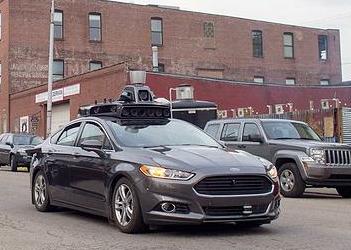
WASHINGTON, DC, September 21, 2016 (ENS) – “Automated vehicles have the potential to save thousands of lives, driving the single biggest leap in road safety that our country has ever taken,” said U.S. Transportation Secretary Anthony Foxx on Monday, announcing the federal government’s new policy for the safe testing and deployment of automated vehicles.
Self-driving cars have enormous potential for improving safety and mobility for Americans on the road, U.S. transport officials believe, but only if the policy moves beyond the conventional “reactive” U.S. auto regulatory approach and becomes a proactive measure.

“This policy is an unprecedented step by the federal government to harness the benefits of transformative technology by providing a framework for how to do it safely,” said Secretary Foxx.
“Ninety-four percent of crashes on U.S. roadways are caused by a human choice or error,” said Dr. Mark Rosekind, administrator of the US National Highway Traffic Safety Administration (NHTSA). “We are moving forward on the safe deployment of automated technologies because of the enormous promise they hold to address the overwhelming majority of crashes and save lives.”
It is possible for an self-driving car to crash, of course. The first fatality in such a car happened May 7 in Williston, Florida, when a tractor-trailer made a left turn in front of a Tesla Model S electric car in self-driving mode, and the car failed to apply the brakes.
The crash killed the Tesla driver; it was the first known fatal accident in the United States involving a self-driving vehicle.
The Federal Automated Vehicle Policy released Monday is a product of much public input and stakeholder discussion, including two open public meetings this year and an open public docket for comments.
“Public input has been essential to getting this right,” said Secretary Foxx. “There has been a strong call from state and local governments, industry, safety experts, mobility advocates, and average Americans to establish a clear policy for the deployment of automated vehicles on our roads.”
“There are huge upsides and significant challenges that come with automated vehicle technology, and we will continue the conversation with the public over the coming months and years as this technology develops,” he said.
The primary focus of the policy is highly automated vehicles, or those in which the vehicle can take full control of the driving task in at least some circumstances.
Parts of the policy also apply to lower levels of automation, including some of the driver-assistance systems already on the road.
The new policy has the support of Colleen Sheehey-Church, national president, Mothers Against Drunk Driving, MADD.
“MADD is proud to support the Department as it releases its policy on automated vehicles because we see a future where self-driving cars will save thousands of lives on our roads,” said Sheehey-Church. “A self-driving car can’t get drunk. A self-driving car can’t get distracted. And a self-driving car will follow the traffic laws and prioritize safety for pedestrians and bicyclists.”
The new policy rests on four foundations.
15 Point Safety Assessment – The Vehicle Performance Guidance for Automated Vehicles for manufacturers, developers and other organizations includes a 15 point “Safety Assessment” for the safe design, development, testing and deployment of automated vehicles.
Model State Policy – This section presents a clear distinction between federal and state responsibilities for regulation of highly automated vehicles, and suggests recommended policy areas for states to consider with a goal of generating a consistent national framework for the testing and deployment of highly automated vehicles.
NHTSA’s Current Regulatory Tools – This section outlines NHTSA’s current regulatory tools that can be used to ensure the safe development of new technologies, such as interpreting current rules to allow for greater flexibility in design and providing limited exemptions to allow for testing of nontraditional vehicle designs more quickly.
Modern Regulatory Tools – This discussion identifies new regulatory tools and statutory authorities that policymakers may consider in the future to aid the safe and efficient deployment of new lifesaving technologies.
The U.S. armed forces see much value in automated vehicles.
General James T. Conway (Ret.), 34th Commandant of the Marine Corps and co-chair of SAFE’s Energy Security Leadership Council, said, “Through my decades of service in the U.S. Marine Corps, I have witnessed first-hand the staggering burden in both resources and lives that oil dependence places on our military. If deployed properly, driverless cars will significantly increase quality of life for all Americans through improved safety and accessibility of transportation – and will also reduce our over-dependence on petroleum.
“The Energy Security Leadership Council looks forward to reviewing NHTSA’s recommendations, which are largely aligned with those we put forth in our National Strategy for Energy Security, to enable an ‘innovation-first’ approach that advances this critical technology,” said General Conway.
A March 2016 DOT study finds that current federal Motor Vehicle Safety Standards do not directly address automated vehicle technologies. Those standards can take many years to develop and are traditionally put into force only after new technologies have penetrated the market.
Instead, the new AV policy envisions greater transparency as the transportation agency works with manufacturers to ensure that safety is appropriately addressed on the front-end of development.
“New technologies developed in the 20th century, like seat belts and air bags, were once controversial but have now saved hundreds of thousands of American lives,” Secretary Foxx said. “This is the first in a series of proactive approaches, including the release of a rule on Vehicle to Vehicle communications, which will bring lifesaving technologies to the roads safely and quickly while leaving innovators to dream up new safety solutions.”
NHTSA will have recall authority over automated vehicle technologies. The agency emphasizes that semi-autonomous driving systems that fail to adequately account for the possibility that a distracted or inattentive driver-occupant might fail to retake control of the vehicle in a safety-critical situation may be defined as an unreasonable risk to safety and subject to recall.
Copyright Environment News Service (ENS) 2016. All rights reserved.
